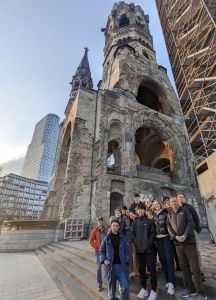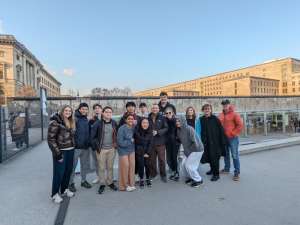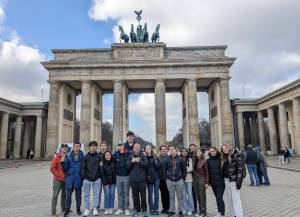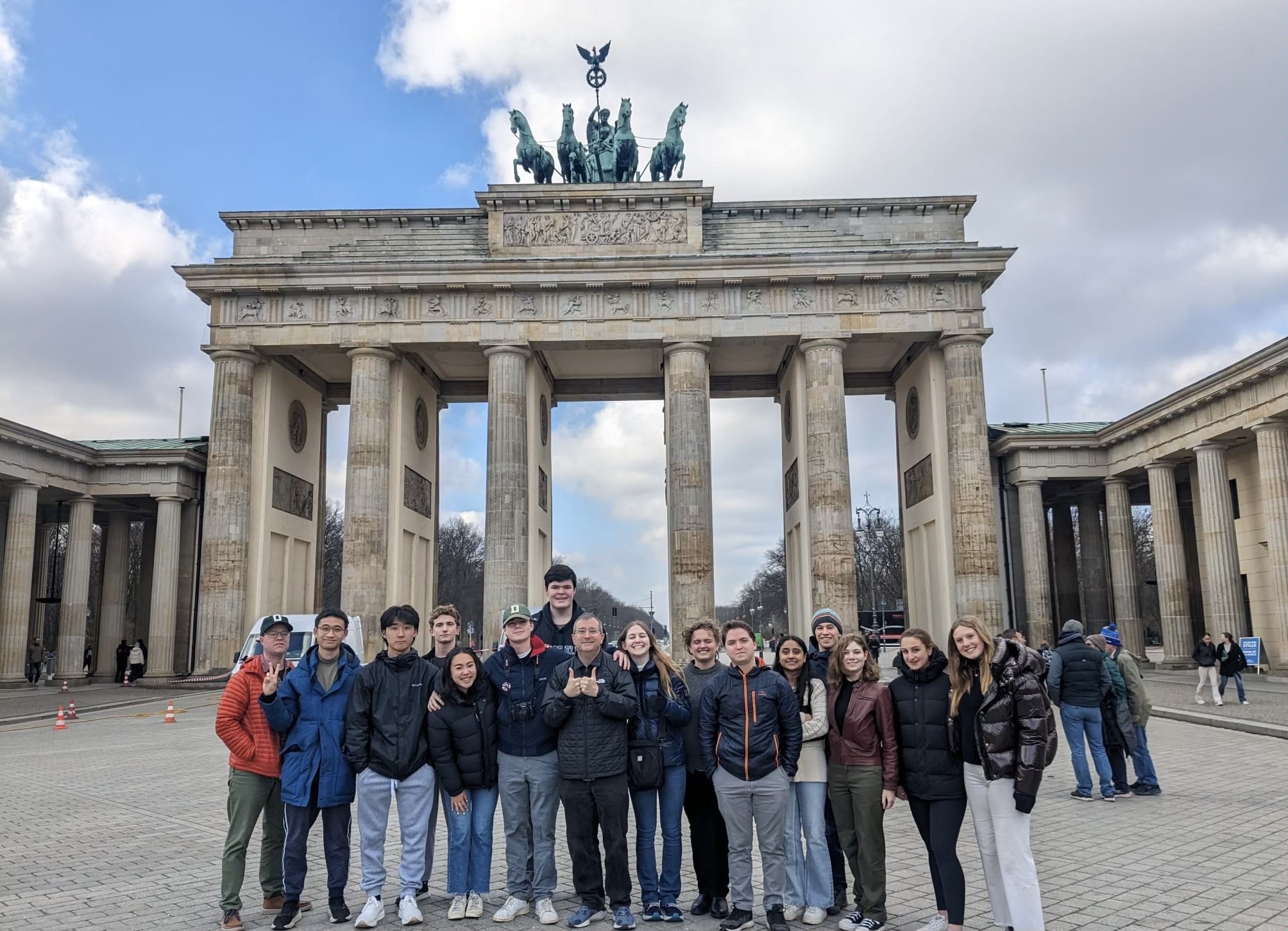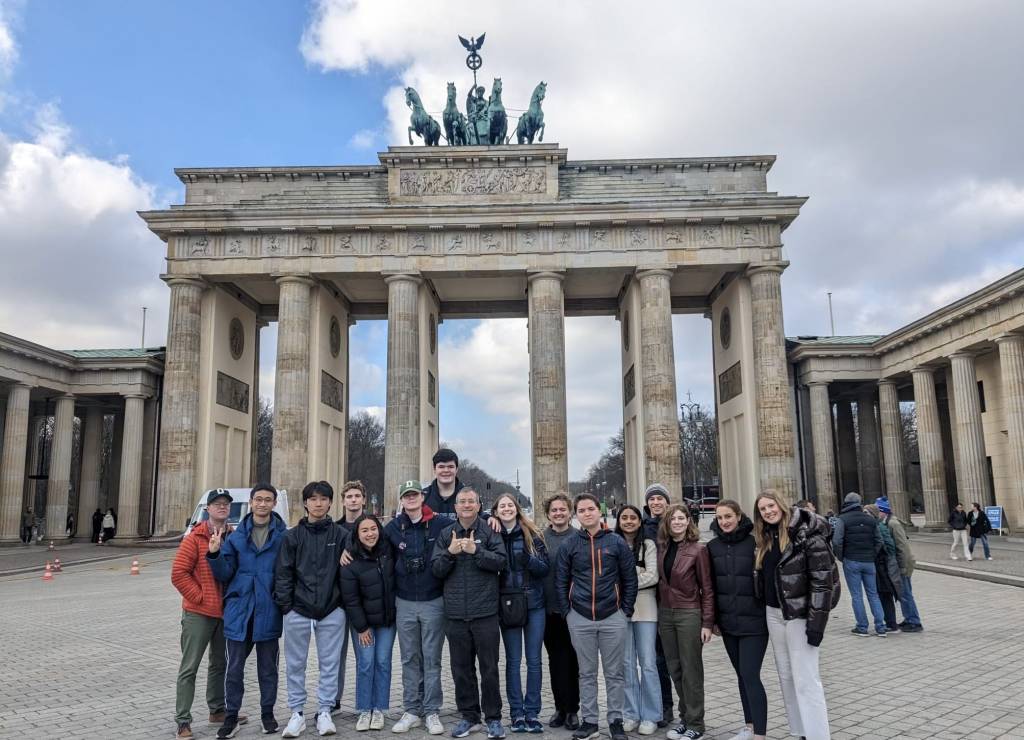Oliver ’26, Avery ’24, Sasha ’25, and David ’25, reflect on their time visiting historic memorials and monuments of Berlin.
Our morning began with a combined bus and walking tour of Berlin and its most famous buildings. We saw from the street many beautiful and unique churches, libraries, and government buildings. A particularly interesting point was Checkpoint Charlie. We also visited the Memorial to Europe’s Sinti and Roma Murdered under Nazism. Located near both the Reichstag and Brandenburg Gate, the monument offered a touching and simplistic reminder of an often overlooked victim of the Holocaust. We were encouraged to reflect on its design and impact. Architecturally, the monument is heavily dependent on the nearby text and itself is a simple pool. It was in stark contrast to the surrounding structures, which told stories through sculpture and elaborate ornamentation. This juxtaposition was a common theme throughout the day, as we observed the stark differences in fascist and Weimar facades, the modern addition to the Reichstag, and the controversial Memorial to the Murdered Jews of Europe.
-Oliver ’26
This morning, Mr. Leistler posed a simple question that stuck with me: “What monuments work and what ones do not? Why?” This question would later form the basis for my curiosity when we arrived at the Memorial to the Murdered Jews of Europe. Made of two thousand concrete stones placed at various heights, I couldn’t help but initially question the memorial’s relation to the Holocaust. How could Peter Eisenman win one of the most important memorial competitions in Berlin just to construct a maze of wordless grey blocks? When finding my way through this unsettling outdoor puzzle, there seemed to be no clear message, goal, or way out. Instead of reading facts and dates, or peering at historical documents like typical memorials, my brain was distracted by how the stones cast odd shadows of the morning sun and the temporary panic of almost being blindsided by visitors walking into us. It was only after we made it out of the concrete rows did I realized their impact.
As I looked back, I realized the boxes were so orderly that they lost their ability to be rational and human. There was no clear nostalgia or memory of the past, but only the vivid memory of my individual experience. Although the silent park did have a more traditional exhibit underground, I felt satisfied with my interaction with these pillars that resembled gravestones. Their somber dissonance reminded me that sometimes, a true understanding of the past is unreachable. Later that morning, a violinist played John Legend songs outside of the Brandenburg Gate. The violinist was playing classical music of the present. He fused together the present and the past. At this moment, I realized he might be onto something.
Although my answer is not complete to Mr. Leistler’s original question, I’ve found the moments where I feel most present help me best understand the past. I’m no monument expert or historian, but I do know that in some ways, monuments can help us understand the past better by allowing us to experience and interact with the material in our way in the present. I’m curious to keep reevaluating my answer to this question as we view more monuments on the trip.
-Avery ’24
After seeing the Reichstag and a short stop for souvenirs and coffee, we headed to go on a walking tour discussing the life of author Christopher Isherwood in Weimar Berlin. Isherwood was the author of the book that was later adapted into the musical Cabaret, and was also a prolific diarist whose diaries remain important historical sources on the changes in Berlin during the 1930’s. Our tour guide was extremely nice and the tour was both educational and entertaining, showing us the history of one man’s life and how it interacted with the vast changes happening in the city around him. It was also a cool experience to be able to walk around a neighborhood where people live and work and really gave us a feel for the vibrancy of the city and its cultural life. The tour was a very successful expedition and helped in understanding the cultural context of Berlin before and during the Nazi’s rise to power.
-Sasha ’25
Before we arrived at the Reichstag, we stopped our day to eat a hearty German lunch of currywurst and fries. The currywurst, a popular dish in Germany, consisted of sausages in a sauce of caramelized onions and spiced ketchup. We enjoyed eating as a group, and with our hunger from the long morning wearing off, we set off for the Reichstag. After a security check and a short elevator ride, we came to the glass dome atop the Reichstag, where we learned about the history of the building and the Berlin skyline. I, David, enjoyed learning about the context of Hitler’s rise to power. Nazism did not occur in a vacuum. Through our exploration of the Reichstag, we learned that Hitler was appointed chancellor of Germany in 1933 and seized emergency powers shortly afterward due to an act of arson on the Reichstag dome. Hitler blamed the communists for the fire and took the opportunity to begin his dictatorship. Learning about the political climate of Germany helped the group begin to understand how and why the Nazi party came to power. I also simply enjoyed the stunning view from the Reichstag dome, which was rebuilt entirely out of glass after the end of the Cold War, symbolizing the transparency of the newly united Germany.
From the viewing platform at the top of the dome, I could see all of the important places we stopped at today: the Brandenburg Gate, the Berlin Wall, the several memorials to those murdered during the Holocaust, and many other historic locations in Berlin. For me, seeing all of Berlin laid out in such a way put into perspective the sheer scale of Berlin and, correspondingly, the huge scale of the turmoil and change in Berlin throughout the 20th century.
-David ’25
